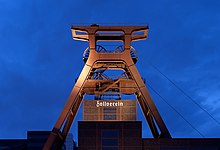Zollverein coal mine

Zollverein Coal Mine, shaft 12
|
|
| UNESCO World Heritage Site | |
|---|---|
| Location |
Essen, Germany |
| Coordinates | 51°29′11″N 7°02′39″E / 51.4865°N 7.0441°E |
| Criteria | Cultural: (ii), (iii) |
| Reference | 975 |
| Inscription | 2001 (25th Session) |
| Website | www |
|
[]
|
|
The Zollverein Coal Mine Industrial Complex (German Zeche Zollverein) is a large former industrial site in the city of Essen, North Rhine-Westphalia, Germany. It has been inscribed into the UNESCO list of World Heritage Sites since December 14, 2001, and is one of the anchor points of the European Route of Industrial Heritage.
The first coal mine on the premises was founded in 1847, mining activities took place from 1851 until December 23, 1986. For decades, starting in the late 1950s, the two parts of the site, Zollverein Coal Mine and Zollverein Coking Plant (erected 1957−1961, closed on June 30, 1993), ranked among the largest of their kinds in Europe. Shaft 12, built in the New Objectivity style, was opened in 1932 and is considered an architectural and technical masterpiece, earning it a reputation as the “most beautiful coal mine in the world”.
Zollverein Coal Mine was found by Duisburg-born industrialist Franz Haniel (1779–1868), who needed coke for steel production. Test drillings in the Katernberg region (nowadays a suburb of Essen) had disclosed a very rich layer of coal, which was then named after the German Customs Union (Zollverein) founded in 1834. In 1847, Haniel founded the bergrechtliche Gewerkschaft Zollverein (a special kind of Prussian corporation for the exploitation of natural resources) and distributed the shares of the new company amongst the members of his family and the landowner of the to-be Zollverein territory.
Sinking of shaft 1 began on February 18, 1847, with the first mineral coal layer being found 130 meters under the surface. First mining activities started in 1851. Shaft 2 (sunk simultaneously with shaft 1) was opened in 1852. Both shafts featured visually identical stone towers and shared a machine house. This concept was to be adapted by many later twin-shaft coal mines.
...
Wikipedia

